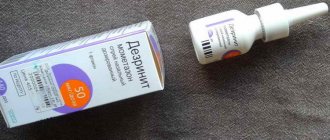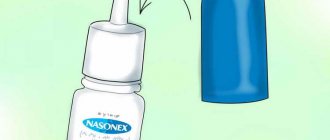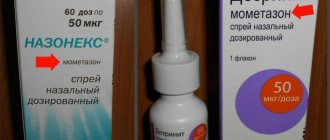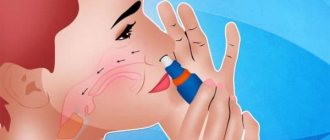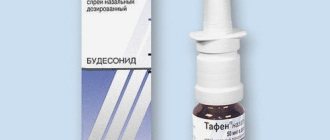Genferon belongs to the group of interferon drugs that were discovered more than 50 years ago. They are active inducers of the innate antiviral response from the immune system, that is, they contribute to the release of their own interferons in the human body.
Nasal drops for children are effective in the treatment of ARVI and influenza, as well as for the prevention of these diseases. The drug can be used from the neonatal period and has proven clinical safety.
Release form and composition
Genferon Light is available in the following dosage forms:
- nasal drops: transparent light yellow or colorless liquid (10 ml each in dark glass bottles, sealed with dropper nozzles or with a dropper nozzle included; 1 bottle in a cardboard box along with instructions for use);
- dosed nasal spray: transparent light yellow or colorless liquid, without mechanical inclusions visible to the eye (100 doses each in dark glass bottles, sealed with a dispenser with a special cap; in a cardboard box 1 bottle and instructions for use of the drug);
- vaginal and rectal suppositories: cylindrical, with a pointed end, white or white with a yellowish tint, uniform in longitudinal section; It is allowed to have a recess in the form of a funnel or an air rod on the cut of the suppository (5 pieces each in blister packs made of polyvinyl chloride film or aluminum foil; in a cardboard pack there are 1 or 2 blister packs and instructions for use of Genferon Light).
Composition per 1 ml nasal drops:
- active ingredients: taurine – 0.8 mg, human recombinant interferon alpha-2b – 10,000 IU;
- auxiliary components of the substance rhIFN-α-2b (recombinant human interferon alpha-2b): sodium acetate trihydrate, sodium chloride, water for injection, glacial acetic acid;
- auxiliary components of the solution: glycerol, polysorbate-80, potassium chloride, potassium dihydrogen phosphate, disodium edetate dihydrate, sodium chloride, sodium hydrogen phosphate, dextran-35,000–45,000, water for injection.
Composition for 1 dose of nasal spray:
- active ingredients: taurine – 1 mg, human recombinant interferon alpha-2b – 50,000 IU;
- auxiliary components: dextran 40,000, glycerol, potassium chloride, potassium dihydrogen phosphate, methyl parahydroxybenzoate, disodium edetate dihydrate, sodium hydrogen phosphate dodecahydrate, polysorbate-80, peppermint oil, sodium chloride, water for injection.
Composition for 1 suppository:
- active ingredients: taurine – 0.005 g, human recombinant interferon alpha-2b – 125,000 IU or 250,000 IU;
- auxiliary components: dextran 60,000, polysorbate-80, citric acid, solid fat, sodium hydrogen citrate, macrogol 1500, T2 emulsifier, purified water.
Pharmacological properties
Genferon Light is a combination drug that has local and systemic effects. The drug has antiviral, anti-inflammatory, immunomodulatory, antibacterial, antioxidant, antiproliferative, membrane stabilizing and local regenerating properties.
Pharmacodynamics
The main active ingredient of Genferon Light is recombinant human interferon alpha-2b, which is produced by strains of the bacterium Escherichia coli with the human interferon alpha-2b gene specially introduced into them (using genetic engineering).
Interferon alpha-2b is able to block the reproduction of viruses at the stage of synthesis of specific proteins. When used intranasally, the drug prevents infection by the virus of uninfected cells of the nasal mucosa, which is the site of invasion of pathogens, as well as the primary inflammatory focus of respiratory infections.
Immunomodulatory properties are manifested by strengthening cell-mediated reactions of the immune system, which increases the body's immune response to the invasion of foreign agents. This effect is achieved due to the activation of NK cells (natural killer cells), CD8+ T killer cells, enhanced differentiation of B lymphocytes and an increase in their antibody production. In addition, interferon alpha-2b increases the expression of MHC (major histocompatibility complex) class I molecules, which ultimately increases the ability of cells of the immune system to recognize infected cells. The drug also activates phagocytosis and cells of the mononuclear phagocyte system (monocyte-macrophage system). Due to the activation of leukocytes, which are contained in all layers of the mucous membrane, their active participation in the elimination of pathological foci is ensured. Under the influence of interferon, the production of secretory immunoglobulin A is restored.
The antibacterial effect of the drug is mediated by the reactions of the immune system, which are enhanced by the influence of interferon.
The second active component of Genferon Light, taurine, normalizes metabolic processes in tissues, promotes faster recovery and regeneration of mucous membranes damaged by the inflammatory process. Taurine is a strong antioxidant, so it directly interacts with reactive oxygen species, the accumulation of which enhances pathological phenomena. Taurine preserves the biological activity of interferon and enhances the therapeutic effect of the drug.
Pharmacokinetics
With the intranasal route of administration (Genferon Light in the form of drops and sprays), a high concentration of interferon is created at the site of infection. The drug has a pronounced immunostimulating and local antiviral effect. Systemic absorption is negligible (human recombinant interferon alpha-2b is detected in small quantities in the blood and lung tissue). The main biotransformation occurs in the kidneys. The half-life (T1/2) is 5.1 hours. A small amount of interferon that enters the systemic circulation exhibits a systemic immunomodulatory effect.
With the rectal route of administration (Genferon Light in the form of suppositories), the bioavailability of the drug is high (more than 80%), so not only a local, but also a pronounced systemic immunomodulatory effect is achieved.
In the case of intravaginal use, due to the significant concentration in the infectious focus and fixation of interferon on the cells of the mucous membrane, a pronounced local antibacterial, antiviral and antiproliferative effect is achieved. But since the absorption capacity of the vaginal mucosa is low, the systemic effects of the drug are insignificant. The maximum serum concentration of interferon is observed 5 hours after the use of suppositories. The main route of elimination is renal catabolism. T1/2 is 12 hours, so Genferon Light must be administered 2 times a day.
Pharmacodynamics and pharmacokinetics
Genferon - nasal drops intended for children.
The features of their pharmacokinetics and pharmacodynamics are as follows:
- When administered into the nasal cavity, a high concentration of interferons is created within a few minutes, so this drug can be used as an emergency protective measure upon contact with an infected person or when the first symptoms of the disease appear.
- The bioavailability of the active component is high and is about 80%.
- Interferon is also able to enter the brain through the sheaths of the cranial nerves, exerting immunomodulatory and regulatory effects.
- Systemic absorption is insignificant, a small content of the active component is observed in the lungs and in the bloodstream. In this case, a weak systemic immunomodulatory effect occurs.
- An increase in the concentration of interferons also occurs in the secretions of the oral cavity, due to which the hyperemia of the pharynx is reduced.
- Metabolism of part of the absorbed drug occurs mainly in the kidneys.
- The half-life is approximately 2 hours.
As laboratory studies show, the introduction of interferon into cell culture leads to a decrease in the destructive effects of viruses in 70-76% of samples. In clinical practice, suppression of the development of infectious diseases is observed in 80% of cases.
Indications for use
Genferon Light in the form of drops is used to treat acute respiratory viral infections (including influenza) in children from the 29th day of life to 14 years.
The drug in the form of a spray is prescribed to adults and adolescents over 14 years of age as a preventive and therapeutic agent for ARVI and influenza.
Indications for the use of Genferon Light in the form of suppositories are:
- acute respiratory viral infections and other infectious diseases of viral and bacterial origin (in children as part of complex therapy);
- infectious and inflammatory diseases of the urogenital tract (in children and women, including pregnant women, simultaneously with specific therapy prescribed and supervised by a specialist).
Reviews, analogues
Reviews about the medicine are mostly positive, especially from parents of young children who have cured ARVI. However, you can also find information that the remedy turned out to be ineffective, this is likely due to the advanced course of the disease or the absence of an integrated approach to treatment.
Genferon light can be replaced with drugs that have a similar effect, containing interferon alpha-2b in their composition:
- Viferon;
- Kipferon;
- Paranox;
- Grippferon;
- Ophthalmaferon;
- Alfaron;
- Human leukocyte interferon;
- Diaferon;
- Ergoferon;
- Anaferon.
Before substituting another drug, you should consult your doctor.
Contraindications
Absolute:
- children's age from 0 to 28 days (for nasal drops);
- children and adolescents up to 14 years of age (for dosed nasal spray);
- first trimester of pregnancy (for suppositories);
- increased individual sensitivity to the main or additional ingredients of the drug.
Relative (Genferon Light is used with caution):
- nosebleeds (for intranasal forms of the drug);
- exacerbation of autoimmune and allergic diseases.
Genferon Light: instructions for use (dosage and method)
Nasal drops
Genferon Light drops are used intranasally. The drug is started to be instilled into the nose when the first signs of the disease appear. The duration of the course is 5 days.
Recommended doses:
- children aged 29 days to 11 months 29 days – 500 IU (1 drop) in each nostril 5 times a day (daily dose is 5000 IU);
- children aged 1 to 3 years - 1000 IU (2 drops) in each nostril 3-4 times a day (daily dose is 6000-8000 IU);
- children and adolescents aged 3 to 14 years – 1000 IU (2 drops) in each nostril 4–5 times a day (daily dose is 8000–10,000 IU).
Dosed nasal spray
Genferon Light spray is used intranasally using an aerosol injection of 1 dose of the drug (1 dose is equal to one short press on the bottle dispenser).
The spray is administered intranasally, starting from the first day of the disease, for 5 days. A single dose is 50,000 IU (one press of the dispenser) in each nostril. The drug should be used 3 times a day. The total daily dose is no more than 500,000 IU of interferon alpha-2b.
For the purpose of prevention (in case of hypothermia and/or contact with a sick person), Genferon Light is administered 50,000 IU into each nostril 2 times a day. Duration of use: 5–7 days. If necessary, the preventive course is repeated.
Instructions for using the spray bottle:
- Remove the protective cap.
- Before first use, press the dispenser several times until a thin stream appears.
- Holding the bottle in a vertical position, inject the spray by pressing the dispenser once, first into one nasal passage and then into the other.
- Close the dispenser with the protective cap.
To avoid the spread of infection, individual use of the bottle is recommended.
Vaginal and rectal suppositories
Genferon Light suppositories can be taken both rectally and vaginally. The method of administration of the drug, the dose used and the duration of the course depend on the age of the patient and the individual clinical situation.
In children under 7 years of age, including infants, the use of interferon alfa-2b at a dose of 125,000 IU per suppository is safe. Children over 7 years of age and adults, including pregnant women at 13–40 weeks, are prescribed Genferon Light at a dose of 250,000 IU of interferon alpha-2b per suppository.
Recommended doses of Genferon Light and treatment regimens:
- ARVI and other acute infections of viral origin in children: 1 suppository rectally 2 times a day (with an interval of 12 hours) simultaneously with the main therapy for 5 days. If symptoms of the disease persist or worsen after 5 days, you should consult a doctor. According to indications, it is possible to repeat the course after a 5-day break;
- chronic infectious and inflammatory diseases of viral origin in children over 7 years of age: 250,000 IU (1 suppository) rectally 2 times a day (with an interval of 12 hours) simultaneously with standard therapy for 10 days. After the 10-day period - 1 suppository rectally (at night) every other day for 1-3 months;
- acute infectious and inflammatory urogenital diseases in children: 1 suppository rectally 2 times a day (with an interval of 12 hours) against the background of specific therapy prescribed and supervised by the attending physician. The course of treatment is 10 days;
- infectious and inflammatory urogenital diseases in pregnant women: 250,000 IU (1 suppository) vaginally 2 times a day (with an interval of 12 hours) for 10 days simultaneously with specific therapy prescribed by a doctor;
- infectious and inflammatory urogenital diseases in women: 250,000 IU (1 suppository) rectally or vaginally (depending on the nature of the disease) 2 times a day (with an interval of 12 hours) for 10 days simultaneously with specific treatment. For persistent infections - 3 times a week (every other day) 1 suppository for 1-3 months.
At what age can the drug be used?
In children, the drug can be used from the 29th day after birth. This is due to the fact that the cells of newborns in laboratory experiments on animals produce an increased amount of so-called “early” interferon, which is detected in humans starting from the 10th week of intrauterine development. Its concentration is several times higher than that in adults.
This substance does not mainly play a protective role, but is aimed at the development and differentiation of tissues in the fetus and newborn. Its highest level is observed in premature infants.
For the normal functioning of many vital processes, a low level of internal interferon is required. Large emissions in newborns can lead to disruption of the functioning of some organs, suppression of cell growth, death of hepatocytes, and damage to the glomeruli of the kidneys.
A possible cytopathic effect, proven when testing the drug on laboratory animals, limits its use in newborns up to 1 month. Infectious diseases at this age significantly activate the production of interferon in the child’s body, which, firstly, circulates in the bloodstream for a long time, and secondly, is metabolized in the liver and kidneys.
As medical studies show, starting from the 10th day after birth, the introduction of this cytokine into the body of newborn animals does not affect the growth and development of cells. There are also no changes in the internal organs. Therefore, in the future the drug is safe for use when interferon status decreases as a result of infectious diseases.
Drug interactions
Intranasal forms of Genferon Light are not recommended for use simultaneously with vasoconstrictors, as this causes even greater dryness of the nasal mucosa.
The greatest effectiveness of Genferon Light is achieved when used as part of complex treatment. The use of other antiviral, antibacterial and fungicidal agents leads to mutual potentiation of action, and this makes it possible to achieve the best overall effect of therapy.
Reviews of Genferon Light
According to reviews, Genferon Light is often used in children and adults for viral infections and diseases of the urogenital tract. The effectiveness of the drug is noted both in the form of drops and spray, and in the form of suppositories. The spray is easy to use, approved during pregnancy, and not bitter. Women who used the drug during pregnancy note its safety for the fetus and its effectiveness against acute respiratory viral infections and influenza. The drug also helps prevent the recurrence of colds. Genferon Light drops and suppositories can be used in children from a very early age.
The disadvantages of Genferon Light, according to users, are: ineffectiveness at the height of the disease or not a pronounced effect of treatment, dryness of the mucous membrane when instilling drops and spraying, itching or burning during vaginal administration, possible allergic reactions, as well as high cost.
Analogs
Genferon - nasal drops for children, having analogues in composition and pharmacological action, indicated in the table below.
| Name | Main components | Release form | Average price, rub. |
| Interferon | Interferon alpha | Solution for topical use and inhalation | 140 |
| Grippferon | Nasal drops | 310 | |
| Lokferon | Lyophilisate for the preparation of solution for injection and topical use | 40 | |
| Infagel | Gel and ointment | 150 | |
| Reaferon-es | Lyophilisate for the preparation of solution for injection and topical use | 1300 | |
| Viferon | Ointment, gel, rectal suppositories | 200 (ointment) | |
| Genferon Light | Spray | 420 | |
| Kipferon | Interferon alpha, normal human immunoglobulin | Rectal and vaginal suppositories | 650 |
Cold and flu medicine Grippferon

